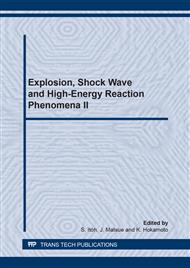p.211
p.217
p.223
p.229
p.233
p.239
p.244
p.250
p.256
Research on Electric Discharge Shock Crush Method Using Thin Wire
Abstract:
Recently, construction methods using gunpowder have been widely used to crush bedrock, concrete, etc. However, when these methods are used in urban areas, there can be negative safety and environmental effects. Therefore, there has been a growing demand for electric discharge shock crush, which is a static, non-blasting crush method that does not use gunpowder. This research aims to develop a method of controlling the crack direction during electric discharge shock crush. For the experiment, we used test pieces with a water-cement ratio of 55%, a height of 200 mm, and a diameter of 100 mm. Then, we created four types of wedge shape to use on the test pieces, including a two-way wedge shape, a three-way wedge shape (a downward wedge is added), a lateral disc wedge shape, and a four-way wedge shape (decahedron). For the discharge characteristics, the current and voltage waveforms had little difference between the test pieces, and it was confirmed that a larger waveform resulted from an increase in the charging voltage. Also, the two-way wedge shape could not control the crack direction. However, the three-way wedge shape could control a crack in the vertical direction and divide the test piece into two pieces. Thus, it is important to have a downward wedge (three-way wedge) to control the crack in the vertical direction. In addition, the lateral disc wedge shape generates a crack in the horizontal direction, and as a result, the test piece was sliced horizontally like a disc. Also, the four-way wedge shape cracked the test piece in the vertical and horizontal directions along the edges of the wedge. In conclusion, it was found that the wedge shape controls the crack directions.
Info:
Periodical:
Pages:
233-238
Citation:
Online since:
July 2013
Authors:
Price:
Сopyright:
© 2014 Trans Tech Publications Ltd. All Rights Reserved
Share:
Citation:


